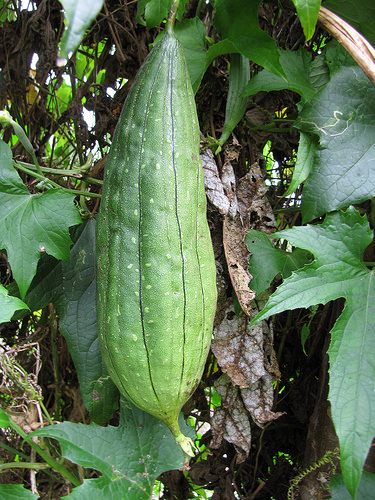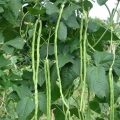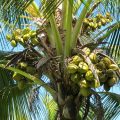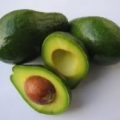Ridged gourd or angled Luffa gourd (Luffa acutangula) and smooth gourd (Luffa cylindrica) are commonly called patola among the Tagalogs and locally known as kabatiti among the Ilocanos and Ibanags. A tropical member of the Cucurbitaceae, the patola plant is an annual vine with tendrils and large, cylindrical fruits that are edible when young. Most patola varieties are monoecious. Male flowers develop in a cluster, whereas female flowers develop singly or in association with male flowers. The lower nodes of patola usually bear only male flowers, followed by nodes having both male and female flowers, which are followed by solitary female flowers at the uppermost nodes.

The mature, dry fruit consists of a hard shell surrounding a stiff, dense network of cellulose fibers. These dense network of cellulose fibers serve as support and dispersal of hundreds of flat, smooth black seeds. They are called luffa or loofah sponge which is commercially manufactured as body scrub.
Patola is closely related to cucumber and modified cultural practices for trellised cucumber production can be used. One must keep in mind, however, that luffa is a tropical plant which requires a long growing season and warm temperature.
SOIL AND CLIMATIC REQUIREMENTS
Patola is adapted to humid tropics. In the Philippines,it can be grown throughout the year. However, for optimum production, select soil types with high organic matter. This crop can be profitably grown in rain-field and irrigated farms but not productive in poorly drained soils. Productive months in growing patola is from June to September and from February to May if there is adequate irrigation.
CULTURAL MANAGEMENT PRACTICES
Selection of Varieties
Two types of patola can be planted for production namely, angular or ridged type and smooth type. For better yield, select varieties of patola that are adaptable in your local conditions and market preference. Varieties of patola and their desirable characteristics are shown in the “Guide in Selecting Lowland Vegetable Varieties” included in this kit.
Land Preparation
Prepare the field as early as possible to give enough time for the weeds and stubbles of previous crops to decompose. Plow and harrow 2 to 3 times alternately at one week interval. Plow at a depth of 15 to 20 cm. Harrow twice to break the clods and level the field. A well-pulverized soil promotes good soil aeration and enhances root formation. Furrows should be set at 2.5 to 3 m distance.
Trellising
Provide the plants with trellis to produce fruits of good visual quality. Trellising is also essential during the wet season to minimize fruit rotting and malformation.
Construct overhead trellises at a distance of 2 to 3 m wide and 2 m high using ipil-ipil or bamboo poles. Provide strong roof trellis by intertwining the wire or nylon twine crosswise and lengthwise on top of the trellis. Provide a ladder-like trellis or vertical pole for each upo plant to facilitate the vines to climb up.
Seed Preparation and Sowing
Soak the seeds in water overnight before planting to facilitate germination. During dry season, plant 1 to 2seeds per hill at a distance of 2.5 m between hills on the furrows. During wet season, plant 2 to 3 seeds per hill on the ridges of the furrows at a distance of 2.5 m between hills to avoid water logging.
Thinning and Replanting
Remove weak and diseased seedlings 3 to 4 weeks after emergence. Retain only one healthy plant per hill. Replant vacant hills.
Vine Training
Train the vines to climb the trellis by tying the stem lightly on the vertical pole or ladder-like trellis until it reaches the overhead trellis. Training should be done weekly.
Fertilizer Application
The kind and amount of fertilizer to apply depends on soil fertility and soil type. To achieve optimum yield, have your soil analyzed at the Soil Laboratory nearest you to determine the right nutrient requirement of the soil.
In the absence of soil analysis, apply the following fertilizers at the time and amount specified:
Irrigation
Irrigate the crop by flooding the area two weeks after emergence. Repeat irrigating at seven (7) days interval throughout the growing season.
Weeding
Weed the area at 14 days after emergence. Cut the weeds close tothe ground every 14 days or as needed. Do notuproot the weeds or cultivate in between the rows as this will harm the roots of the plants. Disturbed roots will affect the growth of vines and result to low yield,continue weeding until the crop has attained considerable vegetative size to cover the trellis. When the trellis is completely covered with the vines it shuts out sunlight needed by the newly germinating weeds, suppressing their growth.
Crop Protection
Crop protection strategy should be based on the population and degree of damage of insect pests and diseases attacking the plants. Patola is very resistant to most insect pests of cucurbits except fruitfly. Most common disease is downy mildew. For prevention and management of of pests and diseases, please refer to the Pests and Diseases Management Guide for Lowland Vegetable included in the kit.
Harvesting
Five days after fruit setting, harvest immature fruits using a sharp knife to cut the peduncle. Pack harvested fruits in 10 kg capacity polyethylene bags to maintain freshness. To avoid the damaging effect of sunlight on the fruits (drying of the ridge), harvest early in the morning or late in the afternoon.
Cost and Return Analysis for Patola
Source: e-extension.gov.ph







(Y)
ambot!
ambot!